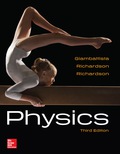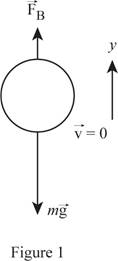
(a)
The weight of beach ball including the air inside it.
(a)
Answer to Problem 102P
The weight of beach ball is
Explanation of Solution
Radius of ball is
Write the equation for the weight of ball with air inside it.
Here,
Conclusion:
Substitute
Therefore, the weight is
(b)
The buoyant force on beach ball.
(b)
Answer to Problem 102P
The buoyant force is
Explanation of Solution
Radius of ball is
Write the equation for buoyant force on each ball.
Here,
Conclusion:
Substitute
Buoyant force will acts in opposite direction of weight. That is directed upwards.
Therefore, the buoyant force is
(c)
The acceleration of ball at the top of its path.
(c)
Answer to Problem 102P
The acceleration is
Explanation of Solution
Radius of ball is
The free body diagram is shown below in figure 1.

Write the equation net force on the ball.
Here,
Rewrite the above equation in terms of
Write the equation to find
Rewrite the equation for
Conclusion:
Substitute
Negative value indicates that the acceleration is directed in downward direction.
Therefore, the acceleration is
Want to see more full solutions like this?
Chapter 9 Solutions
Physics
- The polar ice caps have a combined mass of about 2.65 × 1019 kg. If all of the ice in the polar ice caps melted, by how much time would the length of a day (Earth's rotational period) change? For simplicity, assume each ice cap is an identical thin solid disk with a radius of 7.20 x 105 m. Find the change both in seconds and as a percentage of duration of a day. change in time percent change (No Response) s (No Response) %arrow_forward. A space probe in outer space has a gyroscope within it used for rotation and stabilization. The moment of inertia of the gyroscope is I = 17.5 kg m² about the axis of the gyroscope, and the moment of inertia of the rest of the space probe is I = 5.00 × 105 kg • m² about the same axis. Initially both the space probe and gyroscope are not rotating. The gyroscope is then switched on and it nearly instantly starts rotating at an angular speed of 110 rad/s. How long (in s) should the gyroscope operate at this speed in order to change the space probe's orientation by 24.0°? (No Response) sarrow_forwardSolve thisarrow_forward
- Walking with a steady cadence is very important for covering long distances efficiently. How we place our feet, and how quickly we walk, also depends on the roughness of the surface we are walking upon and on the slope of the surface: we walk carefully on slippery surfaces, and take smaller steps when hiking up a hill. When we are walking at constant speed in a fixed direction, the horizontal and vertical components of the acceleration of our center of mass must be zero. In addition, the sum of torques about the body's center of mass must also be zero. Consider the situation shown in the figure below. ALMA XCM Х СМ XCM XCM XCM We can model the walking gait of a person as a swing of the front leg and torso about the point where the front foot is planted (shown with a red circle in the figure) and a rotation of the trailing leg about the center of mass (CM) of the person. If each leg of this 78.0 kg person is 85.0 cm long and has a mass of 13.8 kg, and 0; = 0₁ = 20.0°, what is the…arrow_forwardYou are attending a county fair with your friend from your physics class. While walking around the fairgrounds, you discover a new game of skill. A thin rod of mass M = 0.550 kg and length l = 2.80 m hangs from a friction-free pivot at its upper end as shown in the figure. Pivot Velcro M Incoming Velcro-covered ball m The front surface of the rod is covered with Velcro. You are to throw a Velcro-covered ball of mass m = 1.20 kg at the rod in an attempt to make it swing backward and rotate all the way across the top. The ball must stick to the rod at all times after striking it. If you cause the rod to rotate over the top position (that is, rotate 180° opposite of its starting position), you win a stuffed animal. Your friend volunteers to try his luck. He feels that the most torque would be applied to the rod by striking it at its lowest end. While he prepares to aim at the lowest point on the rod, you calculate how fast he must throw the ball to win the stuffed animal with this…arrow_forwardA hanging weight, with a mass of m₁ = 0.365 kg, is attached by a rope to a block with mass m₂ = 0.835 kg as shown in the figure below. The rope goes over a pulley with a mass of M = 0.350 kg. The pulley can be modeled as a hollow cylinder with an inner radius of R₁ = 0.0200 m, and an outer radius of R2 = 0.0300 m; the mass of the spokes is negligible. As the weight falls, the block slides on the table, and the coefficient of kinetic friction between the block and the table is μ = 0.250. At the instant shown, the block is moving with a velocity of v; = 0.820 m/s toward the pulley. Assume that the pulley is free to spin without friction, that the rope does not stretch and does not slip on the pulley, and that the mass of the rope is negligible. R₂ R₁ Mo mi (a) Using energy methods, find the speed of the block (in m/s) after it has moved a distance of 0.700 m away from the initial position shown. (No Response) m/s (b) What is the angular speed of the pulley (in rad/s) after the block has…arrow_forward
- A stiff, thin, metal rod with negligible mass is free to rotate in a vertical plane about pivot point P, as shown in the figure below. The rod has three small beads (labeled 1, 2, and 3 in the figure), all with the same mass m, attached to it as shown. The rod is held horizontally and then released from rest at time t = 0. Find all results below in terms of the mass m, distance d, and acceleration due to gravity g. 1 P m m 2 2d 23 m 3 (a) What is the moment of inertia of the system of three particles about the pivot point P? I= (No Response) (b) What is the net torque magnitude about point P at t = 0? Tnet = (No Response) (c) What is the angular acceleration of the system about point P at t = 0? magnitude direction α = (No Response) (No Response) (d) What is the linear acceleration of bead 3 at t = 0? magnitude a = (No Response) direction (No Response) (e) What is the maximum kinetic energy of the system? K = (No Response) max (f) What is the maximum angular speed about point P…arrow_forwardDuring a concentric loading of the quadriceps muscle in the upper leg, an athlete extends his lower leg from a vertical position (see figure (a)) to a fully extended horizontal position (see figure (b)) at a constant angular speed of 45.0° per second. Two of the four quadriceps muscles, the vastis intermedius and the rectus femoris, terminate at the patellar tendon which is attached to the top of the tibia in the lower leg. The distance from the point of attachment of the patellar tendon to the rotation axis of the tibia relative to the femur is 4.10 cm in this athlete. a b (a) The two quadriceps muscles can exert a maximum force of 225 N through the patellar tendon. This force is applied at an angle of 25.0° to the section of the tibia between the attachment point and the rotation axis. What is the torque (in N m) exerted by the muscle on the lower leg during this motion? (Enter the magnitude.) (No Response) N⚫ m (b) What is the power (in W) generated by the athlete during the motion?…arrow_forwardA 3.1-kg sphere is suspended by a cord that passes over a 1.6-kg pulley of radius 3.3 cm. The cord is attached to a spring whose force constant is k = 86 N/m as in the figure below. Assume the pulley is a solid disk. www m (a) If the sphere is released from rest with the spring unstretched, what distance does the sphere fall through before stopping? (No Response) m (b) Find the speed of the sphere after it has fallen 25 cm. (No Response) m/sarrow_forward
- The angular momentum vector of a precessing gyroscope sweeps out a cone as shown in the figure below. The angular speed of the tip of the angular momentum vector, called its precessional frequency, is given by @p = t/L, where is the magnitude of the torque on the gyroscope and L is the magnitude of its angular momentum. In the motion called precession of the equinoxes, the Earth's axis of rotation precesses about the perpendicular to its orbital plane with a period of 2.58 × 104 yr. Model the Earth as a uniform sphere and calculate the torque on the Earth that is causing this precession. (No Response) N⚫ marrow_forwardA space station shaped like a giant wheel has a radius of 121 m and a moment of inertia of 5.12 × 108 kg. m². A crew of 150 lives on the rim, and the station is rotating so that the crew experiences an apparent acceleration of 1g. When 100 people move to the center of the station for a union meeting, the angular speed changes. What apparent acceleration is experienced by the managers remaining at the rim? Assume that the average mass of each inhabitant is 65.0 kg. (No Response) m/s²arrow_forward(a) An asteroid is in an elliptical orbit around a distant star. At its closest approach, the asteroid is 0.640 AU from the star and has a speed of 54.0 km/s. When the asteroid is at its farthest distance from the star of 39.0 AU, what is its speed (in km/s)? (1 AU is the average distance from the Earth to the Sun and is equal to 1.496 × 1011 m. You may assume that other planets and smaller objects in the star system exert negligible forces on the asteroid.) (No Response) km/s (b) What If? A comet is in a highly elliptical orbit around the same star. The comet's greatest distance from the star is 23,300 times larger than its closest distance to the star. The comet's speed at its greatest distance is 2.10 x 10-2 km/s. What is the speed (in km/s) of the comet at its closest approach? (No Response) km/sarrow_forward
 College PhysicsPhysicsISBN:9781305952300Author:Raymond A. Serway, Chris VuillePublisher:Cengage Learning
College PhysicsPhysicsISBN:9781305952300Author:Raymond A. Serway, Chris VuillePublisher:Cengage Learning University Physics (14th Edition)PhysicsISBN:9780133969290Author:Hugh D. Young, Roger A. FreedmanPublisher:PEARSON
University Physics (14th Edition)PhysicsISBN:9780133969290Author:Hugh D. Young, Roger A. FreedmanPublisher:PEARSON Introduction To Quantum MechanicsPhysicsISBN:9781107189638Author:Griffiths, David J., Schroeter, Darrell F.Publisher:Cambridge University Press
Introduction To Quantum MechanicsPhysicsISBN:9781107189638Author:Griffiths, David J., Schroeter, Darrell F.Publisher:Cambridge University Press Physics for Scientists and EngineersPhysicsISBN:9781337553278Author:Raymond A. Serway, John W. JewettPublisher:Cengage Learning
Physics for Scientists and EngineersPhysicsISBN:9781337553278Author:Raymond A. Serway, John W. JewettPublisher:Cengage Learning Lecture- Tutorials for Introductory AstronomyPhysicsISBN:9780321820464Author:Edward E. Prather, Tim P. Slater, Jeff P. Adams, Gina BrissendenPublisher:Addison-Wesley
Lecture- Tutorials for Introductory AstronomyPhysicsISBN:9780321820464Author:Edward E. Prather, Tim P. Slater, Jeff P. Adams, Gina BrissendenPublisher:Addison-Wesley College Physics: A Strategic Approach (4th Editio...PhysicsISBN:9780134609034Author:Randall D. Knight (Professor Emeritus), Brian Jones, Stuart FieldPublisher:PEARSON
College Physics: A Strategic Approach (4th Editio...PhysicsISBN:9780134609034Author:Randall D. Knight (Professor Emeritus), Brian Jones, Stuart FieldPublisher:PEARSON





